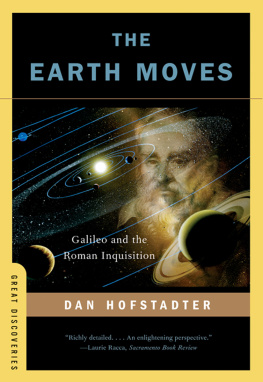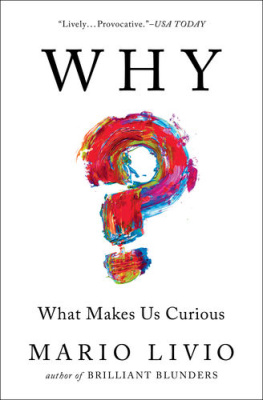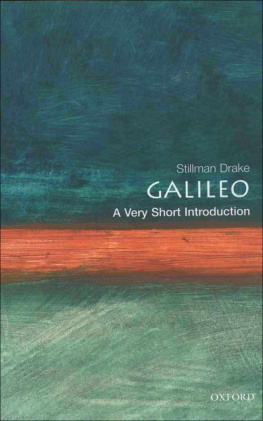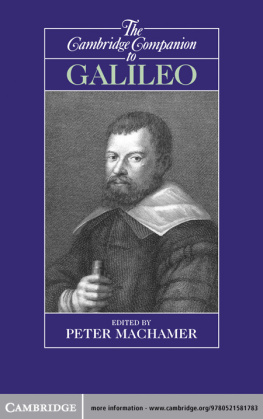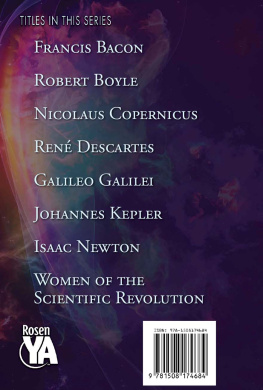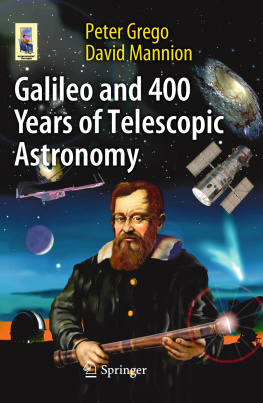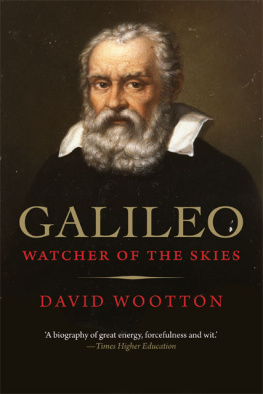GALILEO
DAVID WOOTTON is Anniversary Professor of History, University of York. His previous books include Paolo Sarpi: Between Renaissance and Enlightenment (1983) and Bad Medicine: Doctors Doing Harm Since Hippocrates (2006).

Published with assistance from the foundation established in memory of Oliver Baty Cunningham of the Class of 1917, Yale College
Copyright 2010 David Wootton
First published in paperback in 2013
All rights reserved. This book may not be reproduced in whole or in part, in any form (beyond that copying permitted by Sections 107 and 108 of the U.S. Copyright Law and except by reviewers for the public press) without written permission from the publishers.
For information about this and other Yale University Press publications, please contact:
U.S. Office:
Europe Office:
Set in Arno Pro by IDSUK (DataConnection) Ltd
Printed in Great Britain by Hobbs the Printers Ltd, Totton, Hampshire
A catalogue record for this book is available from the British Library.
Wootton, David, 1952
Galileo: Watcher of the Skies/David Wootton.
p. cm.
ISBN 9780300125368 (cl:alk. paper)
1. Galilei, Galileo, 15641642 2. AstronomersItalyBiography.
I. Title.
QB36.G2W66 2010
520.92dc22
[B]
2010027620
ISBN 9780300197297 (pbk)
10 9 8 7 6 5 4 3 2 1
For Alison
For, all the night,
I heard the thin gnat-voices cry,
Star to faint star, across the sky.
Rupert Brooke, The Jolly Company (1908)
Contents
Illustrations
Frontispiece of Niccol Tartaglia's New Science (1537). The Thomas Fisher Rare Book Library, University of Toronto.
The Ptolemaic universe, from Mattei Mauro's commentary on the Sphere (1550). The Thomas Fisher Rare Book Library, University of Toronto.
The Copernican system, from Leonard Digges's Prognostication Everlasting (1596). Linda Hall Library of Science, Engineering & Technology, Kansas City.
Geometric and military compass. Institute and Museum of the History of Science, Florence.
Sketch from Thomas Seget's friendship book. By permission of the Vatican Library. All rights reserved. Vat. lat. 9385 p. 79. 2010 Biblioteca Apostolica Vaticana.
Peter Paul Rubens, Self-Portrait in a Circle of Friends from Mantua (c.1604). Rheinisches Bildarchiv/Wallraf-Richartz Museum, Cologne.
Galileo's telescope. Institute and Museum of the History of Science, Florence.
Galileo's notebook. By kind permission of the Ministero per i Beni e le Attivit Culturali della Repubblica Italiana/Biblioteca Nazionale Centrale, Florence. All rights reserved. Ms Gal 72 f. 116v.
Moon illustration from Galileo's The Starry Messenger (Venice, 1610), f. 10v. Linda Hall Library of Science, Engineering & Technology, Kansas City.
Moon illustration from pirated version of The Starry Messenger. The Thomas Fisher Rare Book Library, University of Toronto.
Lodovico Cigoli, The Immaculate Virgin (1612), Santa Maria Maggiore, Rome. Photography by Alessandro Vasari, Rome.
Francesco Villamena, engraving of Galileo, frontispiece to Galileo's Assayer (1623). The Thomas Fisher Rare Book Library, University of Toronto.
Francesco Villamena, engraving of Cardinal Bellarmine (1604). Trustees of the British Museum.
Pietro Facchetti, portrait of Prince Federico Cesi. Photograph courtesy of the Accademia Nazionale dei Lincei, Rome.
Attributed to Leandro Bassano, Procurator of San Marco, portrait of Gianfrancesco Sagredo. Ashmolean Museum, Oxford.
Francesco Furini, Astronomy Shows Cosimo I the Satellites of Jupiter, Casino Mediceo, Florence. 2010. Photograph: Scala.
Justus Sustermans, portrait of Cosimo II with his wife and son. Galleria degli Uffizi, Florence. 2010. Photograph: Scala, by kind permission of the Ministero per i Beni e le Attivit Culturali della Repubblica Italiana.
Jacopo Zucchi, fresco of the Villa Medici. Author's photograph.
Title page of Assayer (1623). The Thomas Fisher Rare Book Library, University of Toronto.
Engraving of Maffeo Barberini from his Poemata. The Thomas Fisher Rare Book Library, University of Toronto.
Andrea Sacchi, Divine Wisdom (162933). Photograph courtesy of John Beldon Scott.
Frontispiece to Galileo's Dialogue (1632). The Thomas Fisher Rare Book Library, University of Toronto.
Title page of Melchior Inchofer's Summary Treatise (1633). The Thomas Fisher Rare Book Library, University of Toronto.
Illustration of bone thickness, from Galileo's Two New Sciences (1638). The Thomas Fisher Rare Book Library, University of Toronto.
Illustration of structural failure, from Two New Sciences (1638). The Thomas Fisher Rare Book Library, University of Toronto.
Illustration of equilibrium, from Two New Sciences (1638). The Thomas Fisher Rare Book Library, University of Toronto.
Nineteenth-century construction of Galileo's pendulum clock, based on drawings by Vincenzo Viviani. Science Museum, London.
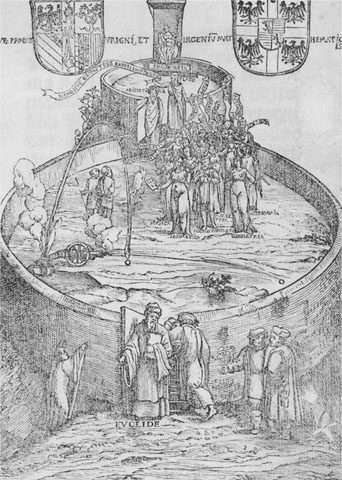
1 The frontispiece of Niccol Tartaglia's New Science (1537) shows Euclid guarding the outer gate to the fortress of philosophy; within are the mathematical sciences (including music and astronomy). Plato guards the inner gate, insisting that no one can enter without a knowledge of geometry a view Galileo shared. On the left two cannon are firing; the paths of their projectiles are evidently not symmetrical.
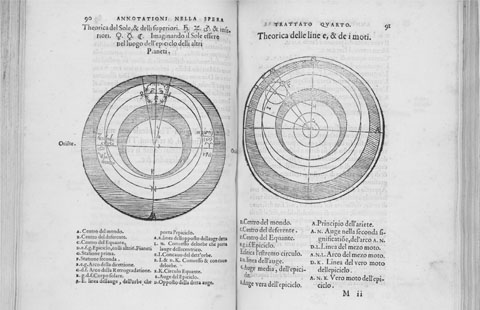
2 The Ptolemaic universe as portrayed in the commentary on the Sphere of Sacrobosco published by Mattei Mauro in Venice in 1550. Galileo lectured on Sacrobosco's Sphere as part of his duties at the University of Padua. Sacrobosco is (it is generally thought) the italianized name of John of Holy wood, an Englishman (c.1195c.1256). The images here show the movements of the planets and of the sun the two are the same, we are told, if one thinks of the sun as occupying the epicycle of a planet.
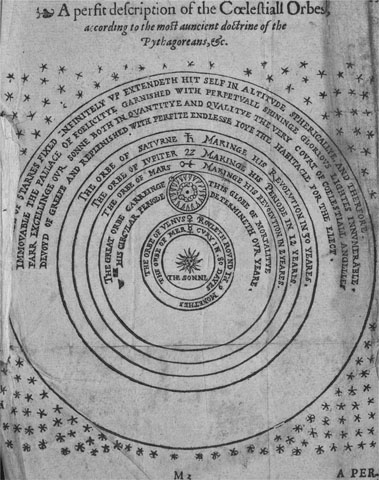
3 The Englishman Thomas Digges, in his Perfit Description of the Clestiall Orbes (1576, here from the edition of 1596), added as an appendix to a reprint of his father Leonard Digges's Prognostication, was the first to portray the Copernican system within an infinite universe. The image seems to have been an afterthought, and binders were unsure whether to bind it as a foldout plate (as here) or as a double-page spread. Galileo is unlikely to have known this work, but he will have been familiar with the idea of an infinite Copernican universe from the work of Giordano Bruno, and may well have read Digges's Copernican The Wings of Mathematics (on the comet of 1572), written in Latin, a copy of which was in Pinelli's library and of course it is conceivable that one of Galileo's English-speaking friends showed him this image in the Prognostication.

4 Galileo's sector (invented in 1597; an instruction manual was privately printed in 1606). The sector (or
Next page

